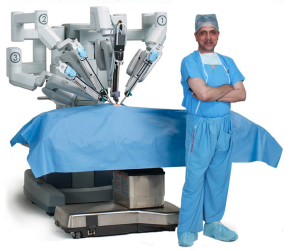Robotic Surgery is the Gold Standard to Minimize Mishaps- Dr. Arvind Kumar
Robotic Surgery is the Gold Standard to Minimize Mishaps- Dr. Arvind Kumar
Moving his fingers on joysticks with élan in the robotic operation theater of Sir Ganga Ram hospital, the renowned robotic surgeon, Dr. Arvind Kumar is a stickler for precision, accuracy and perfection in surgery. And that is why he chose robot as his tool for his vocation as a surgeon. Robot has really proved a handy tool for his surgical ideals. A pioneer of robotic surgery in India, Dr. (Prof.) Arvind kumar, Director Robotic Surgery and Chest Surgery, was in Meditoall office in Noida, sector 60 on 22 September, and talked to meditoall Editor-in-Chief Dhananjay, extensively about how and what of surgeries in India. Former professor of Surgery and Chief of Chest and Robotic Surgery Unit at AIIMS (1988-2012), Dr. Arvind Kumar stands for audit of surgical outcomes and a strict training regimen for surgeons in India.
In India we often hear about surgeries gone wrong. If mishap free surgery be the ideal to achieve, how do you look at Robot as its tool? What about quest for gold standard in surgery?
We can put it this way – in robot as a tool of surgery we have best of both the worlds. Yes, robotic surgery is the gold standard (ya gold standard, you have used a very correct expression). Robotic surgery is doubtless the safest mode of surgery- precise, accurate and nearest to perfection. To avert adverse events, robotic surgery is the best bet. And I want to qualify a bit too – yes, it is the safest but it does not mean there cannot be and never be any mishap if operated upon through robot. There could still be a mishap but that would be rare at the hand of a skilled robotic surgeon. There is a miniscule margin of error that is internationally quantified and documented. Robot failures in surgery amount to a failure rate that is statistically insignificant. All said and done, this should must be kept in mind medicine is essentially an imperfect science.
Should robotic surgery be a norm in all hospitals big and small?
Yes, for accuracy, safety and precision, robotic surgery should be the norm in all operation theatres where major surgeries are involved. It will for sure take some time but talking future scenario robot is going to be an essential ingredient in every operation theatre, both in metros and small towns. It should be so.
What are stops that would have to be pulled to make robotic surgery a norm?
The cost of the robot is prohibitively high (8 crore rupees). There is only one company Da Vinci, which is making surgical grade robot. If hospitals wanted to have return of this investment by charging patients, the cost of the surgery would be so exorbitant that a few only would dare to go for it. The company has made it in a way that in each and every surgery, disposables to the tune of 1 lakh is needed.
So firstly the monopoly over robot making would have to be breached to bring down the cost. That event seems imminent. Many companies of developing nations have already made surgery grade robots and they are talking to us. They are waiting in the wings. The day patent issues with Da Vinci are resolved, they would land the market and the cost of robot would substantially go down. That is going to be sooner than later. Then robotic surgery would accessible to all. Robotic surgery training would also be an issue to deal with.
Till that happens, are you getting clients for robotic surgery?
Cost wise it is different story in Sir Ganga ram. I am doing 30-40 robotic surgeries every month. I left AIIMS only because I could do hardly 4 or 5 cases in a month for I would get robot only once in a week. In Sir Ganga Ram, it is at my disposal always, whenever I want it. Not only am I getting patients wanting to robotic surgery in plenty, I am also doing the kind of robotic surgeries in Sir Ganga Ram no one else is doing in Asia, one of them being most difficult aorto-bifemoral bypass.
Now I tell you why this is different cost wise in Sir Ganga Ram. At my behest, Ganga Ram has made it quite affordable. The hospital does not extract this investment of 8 crore from patients. So the patient has to bear only 1 lakh (one lakh) more, which is for disposables I talked about, than they pay for non –robotic surgery.
Could you shed some light on the evolution of surgery in India to understand why robot is ultimate too?
In the beginning, we had only open surgery. We would make a large incision from below jugular till the end of stomach to do surgery. Incision used to be the wow factor. The bigger the incision, the bigger was the fame of the doctor. It was said big surgeon makes big incision. Head down, we would enter our hand to dabble with vital insides and see them in 3D appearance through naked eye. We had quite a comfortable range of movements with surgical tools.
Then in 1979, laparoscopy (tool of minimal access surgery) arrived. With this, the incision became minimal. The surgeon would enter a tube armed with a telescope. The surgeon would shuffle instrument sent inside through the port, looking on the picture of vital insides in TV screen above. Of course, the large incision, which used to be traumatic to patients, became minimal but in laparoscopy we lost 3D vision, which was a great advantage. The surgical arms’ maneuverability and access was dented. The most difficult part of laparoscopy is suturing after surgery. It is so difficult due to limited movement that even today 90 percent of surgeons’ hands tremble while suturing.
And then the crowning tool robot descended on the scene in 2001. This tool had excellences of both open and minimal access surgery but deficiencies of none. The surgeon handed over the surgical instruments in the hand of the robot and would dabble with joysticks (control column) as if playing some videogame, sitting at the master consol.
Given the growing concern over the mishaps in surgery, do you think India is deficient in surgical training? Should simulation training be made a must?
Given the patient load in India, surgeons here should be more skillful. But for sure, training is a serious issue. Standardization of surgery is indeed needed. Surgeons must have sufficient simulation training before they operate upon real humans. I am for strict training regimen for surgeons.
Should surgeons state the risks involved clearly to patients? Do they do so?
Yes, surgeon should hide nothing from the patients. But this is not the norm. If you remember about laparoscopy, when it started, it was said that it was completely safe. But 5 years down the line they started talking about mishaps in laparoscopy and ghastly videos of mishaps started emerging.
Are you in favor of surgery audit in India in the context of allegations that unnecessary procedures are being done on patients for money?
Yes, I am in favor of audit. It happens in America, Australia, England and other developed countries. There should be audit of surgical outcomes. Inspection and introspection of surgical data is must to ensure quality of surgery but surgeons here are not ready for that because they fear that would expose their pitfalls. The government should mandate audit of surgical outcomes.
What is neglected area in surgery?
Chest surgery is the most neglected area while the need of it is more than any other area. That is why there is hardly half a dozen skilled chest surgeon in India. Chest involves lung food pipe, trachea, pleura, diaphragm and the need for chest surgery is immense. A number of ailments inflict chest area. Due to pollution, lung cancer is number one killer of males in India. TB is assuming serious proportion in India. The lack of skilled chest surgeon is a matter of serious concern in India. It happened because chest training was clubbed with heart and always remained on the fringe. I have so far done 350 surgeries.
Error: Contact form not found.



